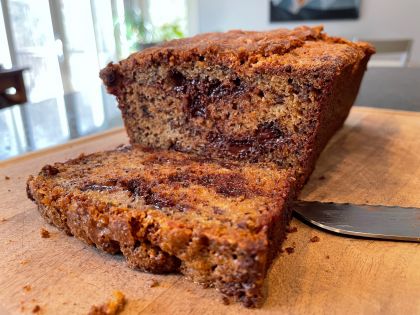2017 Grass Fed
![]()
In 2017, the pasture and the weather resulted in a nice set of steaks from most of our steers. This is an image of what I'd consider an 'average' 2017 steak. It was fairly tender and tasty!
Again, the image quality isn't ideal - I never thought these pictures would end up in a blog post! - but you get the idea: good marbling and nice color.
For a truly pasture-raised and 100% grass fed steak, this is darn good.
2018 Grass Fed
![]()
2018 brought some challenges. The winter was a bit rough and once spring started, there was a TON of rain. Rain, Rain, Rain.
We had a LOT of lush pasture, but the moisture content was so high it bulked up the grass and prevented the steers from getting 'full' -- their bellies were just too full of water to get an ideal amount of energy out of the grasses.
Furthermore, the forage itself grew so fast and the continual rain meant that it wasn't as ideal hay. This impacted us into 2019 since the hay that winter wasn't our usual super high quality.
The steak from 2018 is from the same genetics and management as the 2017 steak.
Check out the complete lack of marbling on this one! I remember being nervous to taste test them. I think they needed to be cooked a bit higher temp than I was used to and sliced thinner, but the flavor was really quite nice.
Still, the resulting inconsistency is an issue for our group - members might have a hard time knowing exactly how to adjust their steak preparation based on how much rain we had that spring!
2019 Barley Finished
![]()
Above is a sample photo from one of the ribeyes off of our barley beef. Not every steak is quite this marbled, but they were all pretty nice.
The 2019 grass fed steaks were mostly better than 2018's, but still behind 2017's quality. This we believe was due to the difficulty in getting the super high quality hay we need for our Minnesota winters.
Check out the difference! We believe this tiny boost of energy, along with a fantastic pasture, provides a more consistent and tasty product.
I think there is an argument that this minor supplementation reduces stress on the animals as they grow and would result in at least as healthy, if not more healthy, food. It is nothing like the overfeeding that we read about on feedlots which causes all the health issues we know about.
I also believe there is an argument that this type of production would sequester MORE greenhouse gas emissions than our 100% grass fed beef, but that's a topic for another post.

















Comments (0)
Add a Comment
Add a Comment